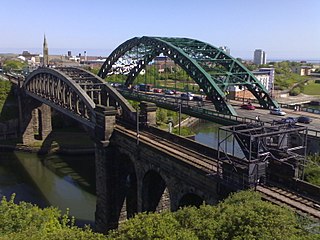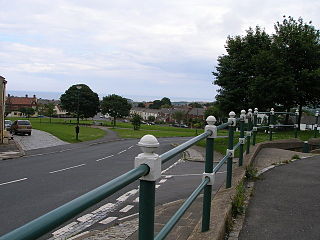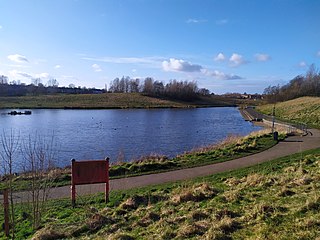
Sunderland is a port city in Tyne and Wear, North East England. It is located at the mouth of the River Wear on the North Sea, approximately 10 miles (16 km) south-west of Newcastle upon Tyne. The city has a population of 168,277, making it the second largest settlement in the North East after Newcastle. It is the administrative centre of the metropolitan borough of the same name.

County Durham, officially simply Durham (/ˈdʌrəm/), is a ceremonial county in North East England. The county borders Northumberland and Tyne and Wear to the north, the North Sea to the east, North Yorkshire to the south, and Cumbria to the west. The largest settlement is Darlington, and the county town is the city of Durham.

Easington, also known as Easington Village, is a village and civil parish in eastern County Durham, England. It is located at the junction of the A182 and B1283, leading north-west to Hetton-le-Hole and south east to Horden.
Following is a list of dates in the history of Sunderland, the ancient city in North East England. Facts and figures, important dates in Sunderland's history.

Houghton-le-Spring is a town in the City of Sunderland, Tyne and Wear, North East England which has its recorded origins in Norman times. Historically in County Durham, it is now administered as part of the Tyne and Wear county.

Shincliffe is a village and civil parish in County Durham, England. The parish population was 1,796. It is situated just over 1 mile (1.6 km) to the south-east of Durham city centre, on the A177 road to Stockton. Shincliffe is also a civil and ecclesiastical parish consisting of Shincliffe Village, High Shincliffe, Sherburn House and Whitwell House.

Whitburn is a village in South Tyneside, in the metropolitan county of Tyne and Wear on the coast of North East England. It is located 3 miles (4.8 km) north of the city of Sunderland and 4 miles (6.4 km) south of the town of South Shields. Historically, Whitburn was a part of County Durham. Other nearby population centres include Seaburn, Cleadon and Marsden. The village lies on a south-facing slope, part of Durham's Magnesian Limestone plateau, which overlooks Sunderland. The population for the combined Whitburn and Marsden Ward in the 2011 UK Census was 7,448. For much of its history, Whitburn was a fishing and agricultural community. The village contains three schools, three churches, a cricket club, recreational grounds, a pub and a variety of shops.

Silksworth is a suburb of the City of Sunderland, Tyne and Wear. The area can be distinguished into two parts, old Silksworth, the original village and township which has existed since the early middle ages, and New Silksworth, the industrial age colliery village which expanded north west of the original settlement. The former colliery being situated to the north west of the village near to the Gilley Law. The population of the ward was 10,931 at the 2011 census.

Monkwearmouth is an area of Sunderland, Tyne and Wear in England. Monkwearmouth is located at the north side of the mouth of the River Wear. It was one of the three original settlements on the banks of the River Wear along with Bishopwearmouth and Sunderland. It includes the area around St. Peter's Church, founded in 674 as part of Monkwearmouth-Jarrow Abbey, and was once the main centre of Wearside shipbuilding and coalmining in the town. It is now host to a campus of the University of Sunderland and the National Glass Centre. It is served by the three Church of England churches of the Parish of Monkwearmouth. The first nineteenth-century Catholic church built in Monkwearmouth was St Benet's Church which remains active today.

The Minster Church of St Michael and All Angels and St Benedict Biscop is the minster church of Sunderland, Tyne and Wear, England. Formerly known as "St Michael & All Angels' Church", it served as the parish church for Bishopwearmouth, but was renamed in January 1998 after Sunderland was granted city status. In May 2007 the Minster ceased to be the parish church of Bishopwearmouth and village is now a suburb of Sunderland. Sunderland Minster is part of the Greater Churches Group.

Farringdon is a suburb of Sunderland, Tyne and Wear, England. Originally a Monastic grange and manor estate for hundreds of years, Farringdon was rebuilt as a post-war council housing estate in the 1950s. It is approximately 3 mi (4.8 km) south of the city centre along the A690, close to Thorney Close, Silksworth, East Herrington, Gilley Law and Doxford Park. Electorally, the area comes under the St. Chad's ward of the City.

Holy Trinity Church is an Anglican church building in Sunderland, Tyne and Wear formerly the area's parish church. It was opened in 1719 as the church for the newly created Parish of Sunderland, and served the local community until dwindling numbers forced its closure in 1988. It has since been in the ownership of the Churches Conservation Trust who have preserved the space and converted it into a community cultural hub.

Sir William Theodore Doxford was a British shipbuilder and politician.

The River Wear in Northern England rises in the Pennines and flows eastwards, mostly through County Durham, to the North Sea in the City of Sunderland. At 60 mi (97 km) long, it is one of the region's longest rivers. The Wear wends in a steep valley through the cathedral city of Durham and gives its name to Weardale in its upper reach and Wearside by its mouth.

In 685, King Ecgfrith granted Benedict Biscop a "sunder-land". Also in 685 The Venerable Bede moved to the newly founded Jarrow monastery. He had started his monastic career at Monkwearmouth monastery and later wrote that he was "ácenned on sundorlande þæs ylcan mynstres". This can be taken as "sundorlande" or the settlement of Sunderland. Alternatively, it is possible that Sunderland was later named in honour of Bede's connections to the area by people familiar with this statement of his.

Sunderland Barracks was a military installation in the old east end of Sunderland, built as part of the British response to the threat of the French Revolution.

Helen Kirkpatrick Watts was a militant British suffragette from Nottingham.

Sunderland Bridge is a village and former civil parish, now in the parish of Croxdale and Hett, in the County Durham district, in the ceremonial county of Durham, England. It is about 3 miles (4.8 km) south of Durham city. In 1961 the parish had a population of 907.

Sunderland City Centre is the central business district in Sunderland, Tyne and Wear, England. The city centre is just to the west of Sunderland Docks.

Bishopwearmouth Rectory was a medieval clerical manor which once dominated the village of Bishopwearmouth, of which is now Sunderland, Tyne and Wear. Overseen by the Bishop of Durham, the rectory hosted many royal officials and papal officers, often appointed in absentee. Throughout the centuries this included notable figures such as Adam Marsh, Simon Langham and Robert of Geneva.




















